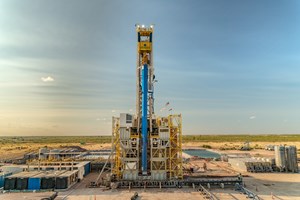Drilling automation streamlines operations, improves safety
Digitalization is changing the face of drilling, allowing rig owners to improve performance and reducing operational costs for operators. The value of this transformation is evident but making the most of it requires an investment that not every company has the resources to make. Nabors has developed technology that not only enhances the performance of its own fleet but also can be deployed on rigs owned by other drilling contractors to deliver similar improvements in safety, efficiency and emissions.
Investing in automation
In 2016, recognizing efficiencies could be captured through automation, Nabors conceptualized what would become rig R801, the world’s first fully automated land rig. The goal of the robotic rig was to demonstrate automation could be deployed to digitize and execute repetitive workflows to improve the efficiency and consistency of operations. Engineers hoped to improve the drilling process and at the same time refocus the work of drillers, who would be able to hand over repetitive, manual, day-to-day tasks to automated systems and focus instead on crew mentorship, operations planning, and specialized activities. Equally important to the developers, this technology reduces exposure to risks by removing personnel from the mast and the rig floor, which are among the most dangerous places on the rig.
The design team evaluated the existing rig operating systems and found that none of the operating systems met their requirements. They set about developing a rig operating system with a machine layer and a flexible sequencing engine that would enable the drilling process to be tailored to specific field requirements and could easily incorporate different equipment components. With this capability, drillers could achieve consistent performance without being restricted to a rigid process, and operators could easily adjust workflows for continuous improvement.
A great deal of effort went into testing full automation capabilities with scenarios that coordinated different machines with multiple actions taking place simultaneously. The results laid the groundwork for the intelligent SmartROS™ rig operating system.
When R801 began operations in the Permian Basin, it achieved measurable performance improvements including reduced connection times. Automation not only expedited the drilling process, it elevated safety performance. R801 had zero recordable incidents throughout the drilling program. Automation minimized NPT, and high-line power supplied to the rig ensured a low carbon footprint. R801 demonstrated fully automated land drilling is possible.
Delivering better performance
Installed on Nabors rigs, the SmartROS™ rig operating system has streamlined drilling operations and created a safer work environment. A system that interfaces with robotics and coordinates activities, such as when a robotic pipe handler picks up a piece of pipe from the ground and hands it to a top drive, predictably executes activities that typically require human intervention. With an automated system, workers have less exposure to dangerous moving parts and spend less time in the red zone, dramatically reducing the risk of incidents and injuries.
Making the rig operating system smarter
The intelligent rig operating system is a platform for digitizing and automating drilling processes, creating the flexibility to deliver value in a range of configurations. Installed on more than 150 Nabors rigs, the SmartROS™ rig operating system has proven its value as a sequencing engine that reads a set of instructions and gives commands to machines that carry out the assigned tasks.
The operating system is built on a Linux platform and uses activity-based workflows that are viewable on an intuitive user interface, which simplifies customization. Since every customer is different, the drilling process cannot invariable. The simple design of this system allows users to drag and drop software to visually sequence each machine. Once sequencing is complete, the file is downloaded onto a process automation system and executed as instructed.
When the system was first deployed on Nabors rigs, drillers used icons representing each drilling function to interface with tools proprietary tools that included an automated directional guidance and execution system: SmartNAV™ and SmartSLIDE™. These solutions incorporate anticollision software and rotary steerable downlinking for consistently accurate directional decisions and exceptional wellbore placement. The guidance system, SmartNAV™, gives instructions to the directional steering control system, SmartSLIDE™, which automates slide drilling, adjusting to unexpected changes in the formation, and improves performance by reducing overall cycle time. Nabors has successfully drilled more than 1,900 wells and millions of feet using these tools.
In early 2019, Nabors embarked on the next steps of drilling process automation with the development of SmartDRILL™, a system that automates repetitive tasks associated with going to bottom and coming off bottom. Utilizing this process automation system, a driller exercises granular control of rig equipment via sequences that automate drilling practices safely and efficiently. These sequences orchestrate equipment functions such that the driller simply enables the system and monitors execution, which frees up time for supervising the drilling process, mentoring the crew and monitoring the downhole environment. Rigs with this solution have lower connection times, better connection consistency and fewer unplanned trips.
The SmartROS™ rig operating system is equipment agnostic. Designed for use on third-party rigs, it can be scaled across any rig fleet even if all the equipment has not been standardized. It integrates with any control system to deliver all the capabilities it enables on a Nabors rig. As of early Q3 2022, Nabors had deployed SmartROS™ on 13 third-party rigs and SmartDRILL™ on three rigs, with another two scheduled for installation by the end of the quarter.
New equipment can be added easily, so rig upgrades do not result in prolonged downtime, and because the system can host third-party applications, it can be deployed as easily on competitors’ rigs as it can on the Nabors fleet.
Other drilling contractors have their own control systems with which the platform must interface, so designers developed a standard interface that allows SmartROS™ to communicate with the sequencing engine, sending commands that can be executed by whatever machines are installed on the drilling rig. This interface is the backbone of process automation.
Refining automation
Although sequencing can be tailored for each drilling program, the sequences themselves do not define the target set points. This is the function of the driller, who determines the parameters that dictate how drilling will progress by developing “recipes” that trigger activities.
The automation framework supports a recipe manager that is controlled by the set points assigned by the driller. The SmartPLAN™ system lets the driller communicate the sequence and identify circumstances that change the drilling process that takes into account depth and formation changes.
Using data gathered while drilling allows asset owners to take the best performing rig and best parameters and apply them across an entire fleet to elevate performance without a hefty investment.
Partnering to improve performance
Nabors is partnering with a global oilfield service company to automate communication between SmartROS™ and the service company’s engineering designs to expand rig automation and improve the reliability of well construction. The goal of this initiative is to enhance interoperability between the well plan and wellsite execution.
Integrating SmartROS™ through the SmartPLAN™ open interface delivers a seamless digital experience for interactive rig activity planning, scheduling, and coordination. It also enables optimization of the drilling recipes and workflows for automated drilling and wellbore placement.
What’s next
Drilling rig control systems are advancing rapidly from automated to autonomous. Today, more and more machines are being automated. The next step is to build intelligent applications that can optimize ROP, improve the accuracy of tool face control, and predict failures to deliver drilling optimization and mitigate drilling dysfunctions in real time.
Data is key to achieving this goal. A rig operating system acting as a centralized data hub at the wellsite can provide data securely to intelligent applications built on the rig operating system. AI can optimize the drilling process as more data is gathered and analyzed.
Automated engine management is the first of many proprietary AI-driven applications that have been deployed successfully, and in the next two years, more applications will be introduced to move industry closer to truly autonomous operations.




